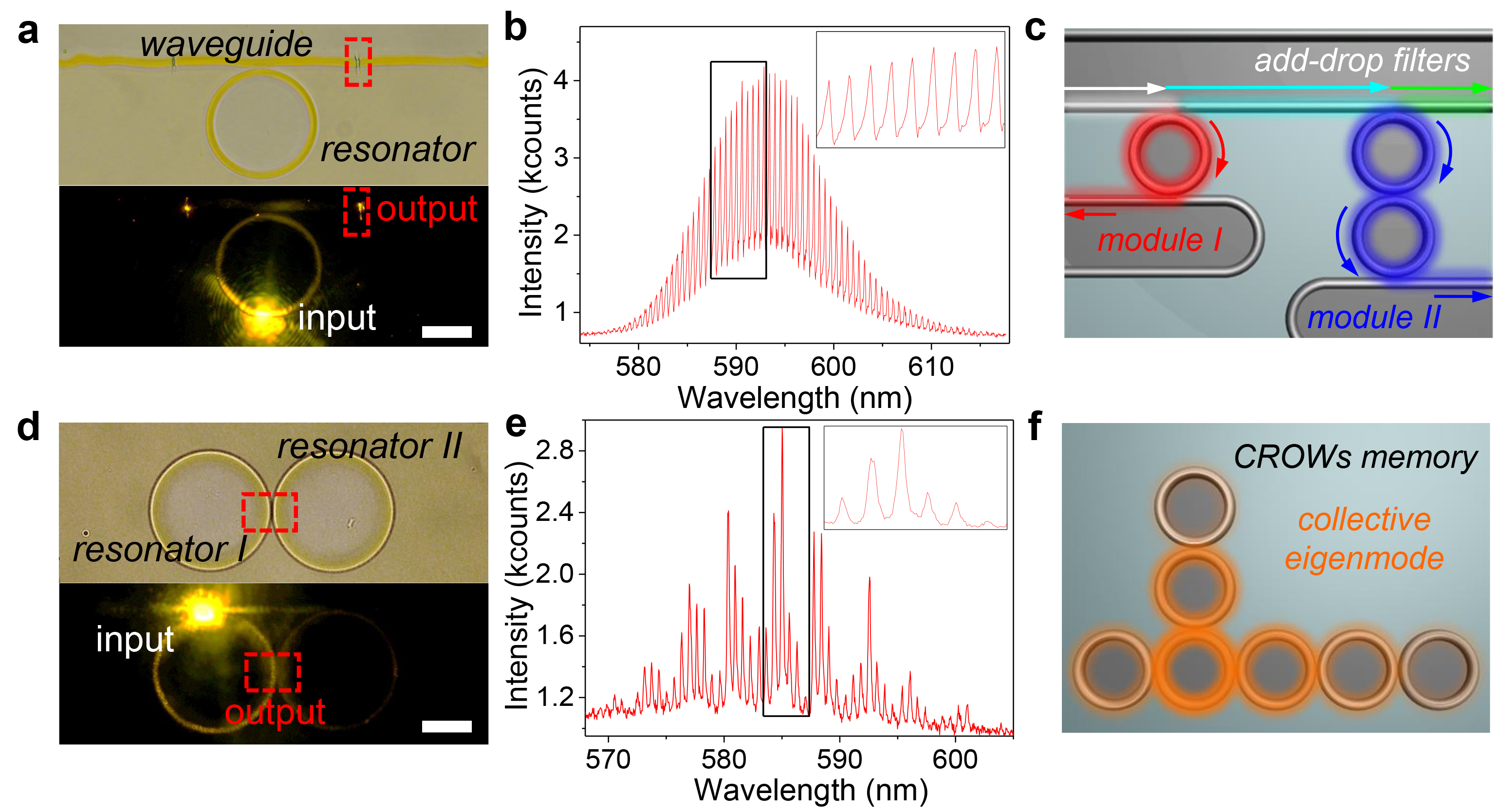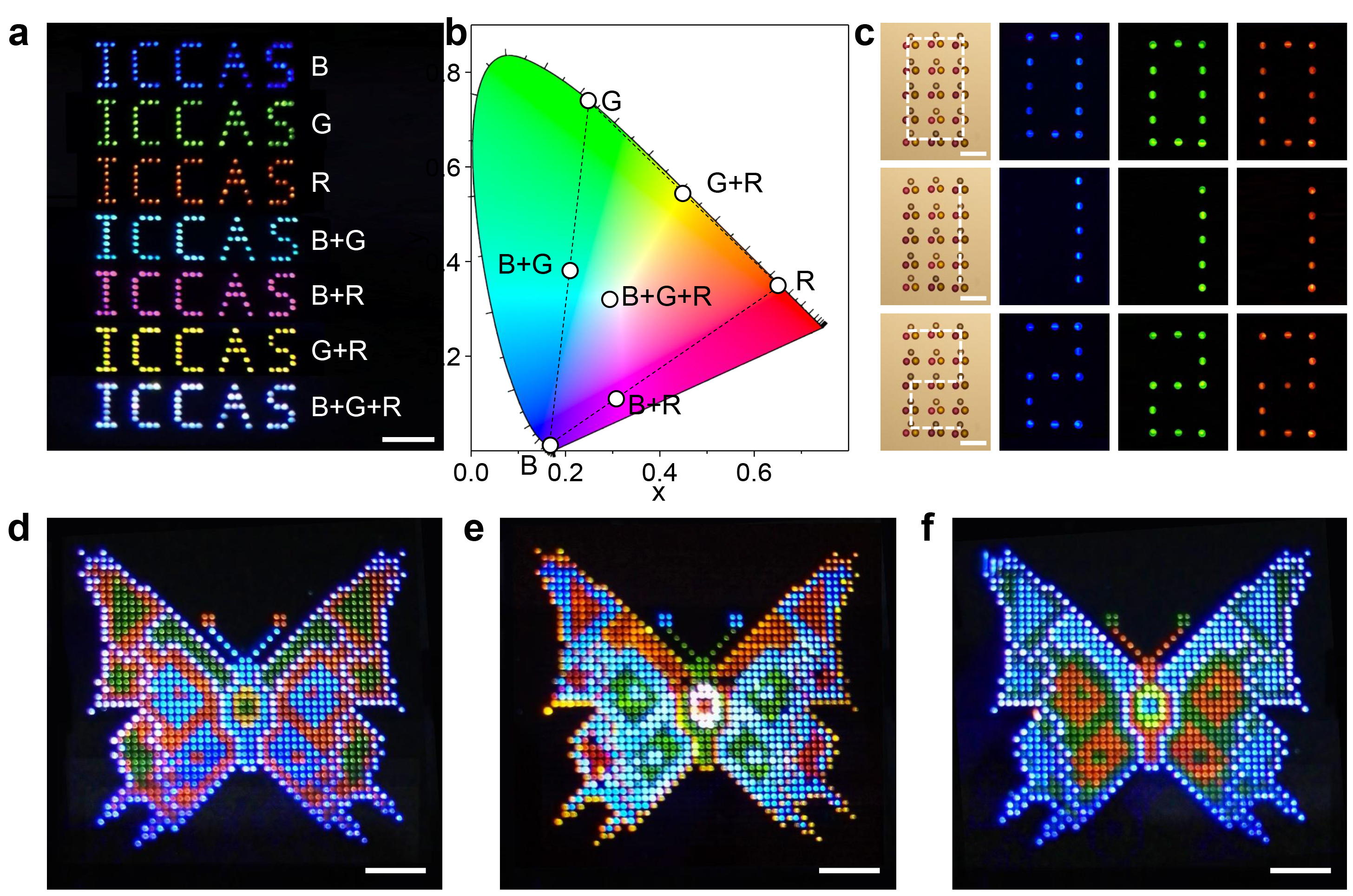 Organic integrated photonic devices
Organic integrated photonic devices
Although organic materials exhibit unique photonic behaviors, there is still lacking a reliable and universal technology to fabricate large-area optical structures with high precision like photolithography for silicon-based materials, which is the main stumbling block behind the integration of organic photonic materials. In recent years, we have developed a series of techniques to realize controllable processing of organic materials into large-area flexible photonic devices toward integrated circuits and microlaser arrays.
1. Controllable processing of organic integrated photonic devices
Individual microlasers and integrated devices based on organic printed photonic materials (Sci. Adv. 2015, 1, e1500257)
A new paradigm shift is proposed for the manufacture of large area flexible organic photonics. We developed a solution-printing strategy for the function-directed, controllable and rapid fabrication of high-quality organic microstructure arrays. Besides the unique mild processing, flexible doping, and active/responsive characteristics, these printed photonic systems show competitive performance compared with their silicon-based counterparts. In light of the rapidly growing flexible electronics market in the past few years, this work promises a bright future for mass production of flexible photonic circuits. (Sci. Adv. 2015).
2. Full-color laser displays based on organic microlaser arrays
Laser displays, known as the next generation display technology after CRT, LCD and LED thanks to high brightness, extreme high resolution, full color gamut have been widely applied in cinema projector. However, flat-panel laser displays for mobile phones, computers and other devices have not yet been implemented as a result of lacking self-emissive laser display panels. Now, we are working on the construction of display panels and the realization of organic electrically pumped lasers for flat-panel laser displays (Acc. Mater. Res. 2021).
Full-color laser displays with organic printed microlaser arrays as panels (Nat. Commun. 2019, 10, 870)
We developed inkjet printing technology to accurately construct RGB microlaser arrays as display panels. Dynamic displays based on such self-emissive panels were realized for information scrolling and video playback, which provides a feasible solution for high-performance, easy-to-process flat-panel laser displays and lighting devices (Nat. Commun. 2019). Taking advantage of difference in wettability of organic dye solutions, we constructed organic core-shell heterojunction microlaser arrays, in which the emission color could be modulated within the full visible spectrum. The color gamut of this display panels exceeds 66% more than that of the standard RGB space (Angew. Chem. Int. Ed. 2020).
Aiming to electrically driven light-emitting display panels, we developed a wettability-guided screen-printing technology to construct large-area pixelated multicolor laser arrays, which is compatible with LED device (Adv. Mater. 2020). Moreover, wearable, stretchable, and foldable displays were successively achieved through processing random microlaser arrays on flexible substrates (Adv. Funct. Mater. 2021; Sci. China Mater. 2021).
3. Optical sensing and information encryption with organic microlaser arrays
The laser signal is featured with high intensity and narrow line width; moreover, the specific excited states of organic laser dyes exhibit distinct responses to external stimuli, which can be amplified through multiple resonances. Benefiting from amplified mechanical, optical, and chemical responsiveness in cavities, we have explored the application of laser arrays as highly sensitive mechanical sensors in smart photonic skin (Adv. Mater. 2021), and as optical barcodes in the fields of information protection and anti-counterfeiting.
Artificial smart skin is a sensor that imitates or/and expands the functions of human skin. We developed a double-layer electron beam direct writing technology for large-scale processing of organic microlaser arrays. Flexible and mechanical sensor network composed of coupled cavity single-mode laser sources were successfully fabricated on a flexible polymer substrate, which serves as excellent sensing units on photonic skin chips for gesture recognition (Sci. Adv. 2021).
Wearable photonic skin based on flexible microlaser arrays (Sci. Adv. 2021, 7, eabh3530)
In general, laser spectrum contains fingerprint information of microcavity structure. On this basis, we designed various encoding methods that can automatically and easily identify organic microlasers, like using a specific barcode to identify products (Adv. Mater. 2017). We also constructed a donor-acceptor lasing system and explored the competition between energy transfer and stimulated emission, which shows huge advantages in information encoding and intelligent anti-counterfeiting (Nat. Sci. Rev. 2021). Moreover, highly secret information encryption and decryption were achieved with circularly polarized microlaser arrays, which provided a new idea for exploring the information encoding application (Adv. Mater. 2021; Research 2020).


